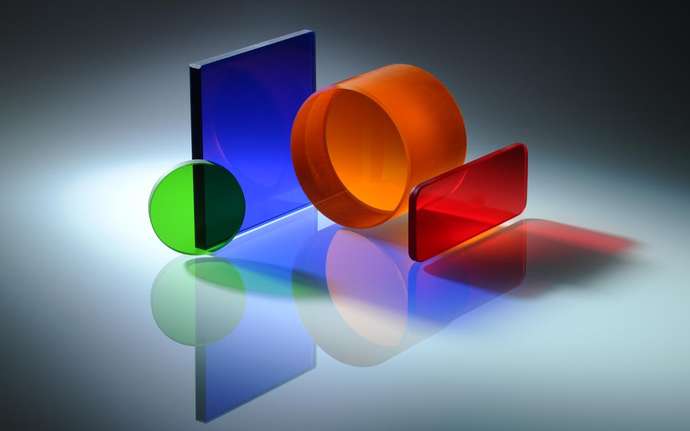
Optical glass forms the foundation of nearly every modern photonic and imaging system—from high-power lasers and scientific instruments to consumer displays and biomedical diagnostics. With dozens of materials developed by world-class manufacturers such as SCHOTT, Corning, Hoya, and Ohara, choosing the right glass for a given application requires deep technical understanding.
This article provides a comprehensive overview of the most widely used types and grades of optical glass, including their properties, performance specs, and real-world applications across industries.
1. Technical Borosilicate Glasses

SCHOTT BOROFLOAT® 33
- Type: Borosilicate float glass
- Thermal Expansion: 3.25 × 10⁻⁶/K
- Transparency: High in VIS/NIR
- Use Cases: Microfluidic chips, optical windows, beam splitters, lab-on-chip, carriers for lithography
- Notes: Excellent chemical resistance, thermal shock resistance, optically flat
2. Display-Grade and Thin-Substrate Glasses

Corning EAGLE XG®
- Type: Alkali-free aluminosilicate glass
- Use Cases: TFT-LCD, OLED, ITO/FTO coatings, flexible circuit integration
- Features: RoHS compliant (lead/arsenic-free), ultra-flat, excellent for photolithography
- Thickness Range: 0.3–1.3 mm
Corning D263T®
- Type: Ultra-thin borosilicate
- Thickness Range: 0.1 mm – 1.1 mm
- Use Cases: Camera modules, microfluidics, AR coatings, mobile device optics
- Benefits: Scratch-resistant, optically clear, ideal for wafer-level integration
3. General-Purpose Optical Crown Glasses

N-BK7 (SCHOTT) / H-K9L (Hoya)
- Type: Borosilicate crown glass
- Refractive Index (nd): 1.5168
- Abbe Number: 64.17
- Use Cases: Lenses, prisms, windows, beam splitters
- Notes: Excellent balance of performance and cost, widely available
SCHOTT B270
- Type: Soda-lime crown glass
- Transparency: >91% in visible range
- Use Cases: Spectroscopy cuvettes, optical windows, general optics
- Strengths: Cost-effective, good polishability
4. High Refractive Index Glasses
SF Series (e.g., SCHOTT SF2, SF10)
- Type: Dense flint glass
- Index Range: 1.6 – 1.8+
- Use Cases: Compact lens systems, microscopes, zoom modules
- Strengths: High dispersion for aberration control, used in complex designs
5. Low Dispersion Glasses for Color Correction
FPL51 (SCHOTT) / H-FPL51 (Hoya) / S-FPL53 (Ohara)
- Type: Fluorophosphate glass
- Features: Low dispersion, moderate index
- Use Cases: Apochromatic triplet lenses, ED objectives, astro-optics
- Notes: Critical for color correction in high-resolution systems
6. UV and Deep UV Grade Glass
Fused Silica (e.g., JGS1, Suprasil®)
- Transmission: From 180 nm (UV) to 3 µm (IR)
- Benefits: Ultra-high purity, high thermal stability, radiation resistance
- Use Cases: Excimer lasers, UV photolithography, space optics
7. IR and Specialty Laser Glasses
| Material | Spectral Range | Application |
|---|---|---|
| ZnSe | 0.6–16 µm | CO₂ laser optics, IR sensors |
| Germanium (Ge) | 2–14 µm | Thermal imaging, surveillance lenses |
| CaF₂ | 0.13–9 µm | UV lasers, UV/VIS optics, spectroscopy |
| Sapphire | 0.15–5.5 µm | IR windows, laser domes, high-durability optics |
8. Summary Comparison Table
| Glass Type | Key Feature | Refractive Index (nd) | Abbe Number (Vd) | Typical Use |
|---|---|---|---|---|
| N-BK7 / H-K9L | Balanced crown glass | 1.5168 | 64.17 | Lenses, prisms, windows |
| SF10 | High-index flint glass | 1.728 | 28.41 | Compact optics, microscopes |
| FPL51 / S-FPL53 | Low dispersion ED glass | 1.497 | 81.6+ | Color-corrected lenses |
| D263T | Ultra-thin glass | ~1.52 | ~60 | Camera modules, thin wafers |
| BOROFLOAT® 33 | Borosilicate, low expansion | 1.47 | ~64 | Substrates, covers, microfluidics |
| EAGLE XG® | Flat display glass | 1.51 | ~60 | TFT substrates, OLED backplanes |
| Fused Silica (JGS1) | UV-grade, low expansion | 1.458 | ~67 | Laser optics, UV systems |
9. Key Considerations When Choosing Optical Glass
When specifying optical glass for a project, engineers must balance:
- Refractive index & dispersion (optical design parameters)
- Thermal and chemical resistance (operating environment)
- UV/IR transmission (spectral performance)
- Surface quality and polishability (precision optics)
- Cost and availability (project scale)
Conclusion
From Schott BOROFLOAT® 33 and Corning EAGLE XG® to ultra-thin D263T and low-dispersion FPL51, the modern optical design engineer has access to a vast toolkit of specialized materials. Each glass type addresses unique performance needs—from thermal stability and UV transparency to micro-patternability and environmental durability.
Whether you’re designing a biophotonic sensor, high-energy laser system, or semiconductor lithography mask, choosing the right grade of optical glass is critical to long-term performance and system integrity.
